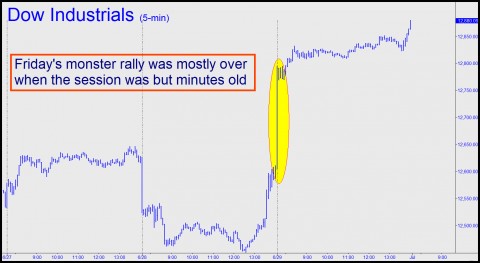Explosive rallies like the one we saw on Friday are opportunistic, launched to milk the last ounce of buying power from ostensibly positive news – in this case, word that Europe had come up with yet another plan to deal with its financial crisis. Of course, the very word “milk” implies that there were agents working behind the scenes to stage-manage the rally. This is not exactly correct, although it is close enough to the truth to stand scrutiny. Here’s how it works. Although we all “know” that Europe cannot possibly grow its way out of its mess, and that sooner or later the euro currency system will unravel, the mere pretense of doing something about it will always be sufficient to buy more time, at least until the day arrives that the system actually does fail. This means that those who have bet on the collapse of the banking system will continue to lose money until the day they are right, but not before. And while that day may seem inevitable to many of us, betting on it – especially with put options whose value decays with each passing week — presupposes a gift for timing that few humans possess. Indeed, it’s possible that perfunctory bailouts of no real consequence could keep the markets afloat for yet more months or years, if not indefinitely. This prospect should not seem farfetched to anyone who has watched the cycles of feigned hopefulness alternate with periods of disappointment and despair. In the lingo of chartists, we might say that waves of mass psychology have been “trading in a range.”
Looking at it from the technical side, these spectacular rallies occur simply because those who make their living by taking the other side of them step away whenever a stampede of buyers, including bears desperate to meet margin calls, comes thundering their way. They have quite a bit of latitude to avoid getting trampled, and so, inundated by a tidal swell of market orders, they simply raise their offers as high as they feel necessary to temporarily satiate the demand. Of crazed buyers, the pros who fade them would say, “If you’re desperate enough not to care how much you pay for this stock, then I will sell it to you at a price that doesn’t leave me equally desperate to get it back.” That is why more than two-thirds of Friday’s rally occurred before anyone had actually bought or sold any stock. Although the Dow Industrials finished the day with a 277-point gain, 193 points of it occurred in the first minute or two of the session, on what is known as a “gap” opening. Almost no stock changed hands during this interval; the first time that was to occur was after the pros on the other side of the bet had opened the 30 Dow stocks substantially higher. The effect was that those who attempted to “act on the news” were a day late.
Traders are soon to discover, or perhaps relearn, that this game is played with stocks moving down as well as up. Thus, bears who have been waiting patiently for months or even years to “even the score” are destined to see the hoped-for opportunity come and go in mere minutes. To be on board, permabears will need to have been short the night before — except that previous day’s session will most likely have ended with a short-squeeze spike that few of them will have survived.
***
Making money in such treacherous markets is going to call for great patience and skill. Click here if you’d like to see how Rick’s Picks approaches this challenge.


Biderman opines that the buyers are companies buying their own stock with inflated retained earnings due to FX swings in their favor. Helps with bonus compensation for CEOs but not the guppies and rubes. Makes sense. He claims 80% is this action. Second leg down still beginning now IMO. Wonder what LIBOR really is right now without the lying.